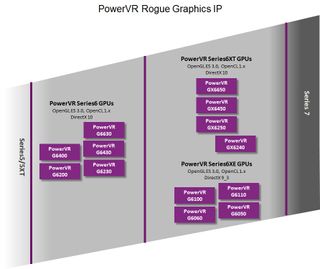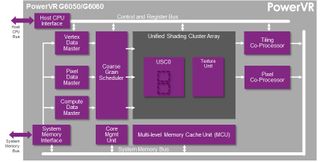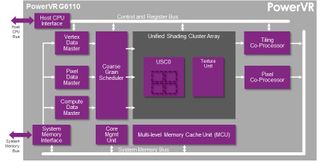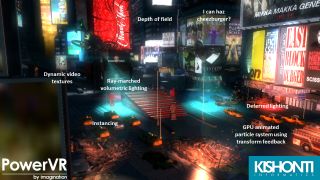Rogue Squadron: Imagination Technologies PowerVR Series6X
So, a new Consumer Electronics Show is upon us, and with it a new set of revisions to Imagination Technologies' PowerVR Rogue GPU core - as made famous in last year's Apple A7 SoC.
This time around, the core has been revised into two distinct groups: the premium Series6XT for high-end and upper mid-range devices, and the Series6XE for mid-range, lower-end, and budget devices.

The Rogue GPU core continues to focus on clusters over traditional cores, but now offers optimizations in speed, bandwidth consumption, and power efficiency, boasting up to a 50 percent improvement over the previous Series6 products of last year.
Rogue Series6XT
For premium devices, the high performance Rogue Series6XT comes in four configurations: PowerVR GX6250, GX6450, GX6650, and GX6240.

The first three are fully-featured implementations with two, four, and six shading clusters (respectively), while the GX6240 is an area-optimized two cluster implementation, where area optimization literally means cutting down transistor counts wherever possible without hobbling capability. All four of these GPU cores are designed to offer the same high-fidelity image rendering and framerate across the entire range, meanwhile being efficient on both power and memory bandwidth.
6XT furthermore builds on the previous Series6 Rogue via a number of optimizations. First is an improved instruction set for even better application performance and increased GPU efficiency. Second, a next-gen Hierarchical Scheduling Technology (HST) further increases resource utilization, which involves a combination of driver-based scheduling, optional multi-core scheduling (demand driven workload distribution across GPU cores), Microkernel firmware scheduling, coarse grain scheduling (programmable, per-cluster distribution), and cluster thread scheduling (data driven, massively multi-threaded, and multitasking). Third, sustained polygon throughput and pixel fillrate improvements offer ever more responsive and fluid graphics. And finally, GPU compute data path optimizations were tuned with real world practical applications in mind to provide higher parallel processing performance.
The idea is that Series6XT is more forward-looking than the previous core, with a better OpenGL ES 3.0 implementation and the kind of performance that Augmented Reality/Virtual Reality and GPGPU apps might require.
Rogue Series6XE
For budget and cheaper mid-range devices, Series6XE is offered in two variants, Half Cluster and Full Single Cluster, and each comes in two SKUs.
Stay on the Cutting Edge
Join the experts who read Tom's Hardware for the inside track on enthusiast PC tech news — and have for over 25 years. We'll send breaking news and in-depth reviews of CPUs, GPUs, AI, maker hardware and more straight to your inbox.
The first Half Cluster core design is the PowerVR G6050, which happens to be the smallest fully-featured GPU core available from Imagination. It supports both OpenGL ES 3.0 and OpenCL 1.x, and also provides a highly-efficient fillrate throughput. The G6050 is intended for entry-level devices.

Moving on, the PowerVR G6060 core augments the half-cluster design of the G6050 with the addition of PVRIC2 (Imagination’s second generation lossless PowerVR Image Compression), providing an optimal balance of small size and bandwidth reduction. It's not really gaming focused, but rather more geared towards HDTVs and set-top boxes.
And for the mid-range and embedded sectors, Imagination offers two Full Single Cluster designs. The first of which is the PowerVR G6100, an updated and further optimized version of the original area-optimized Series6XE Rogue core. A single Unified Shader Cluster (USC) combined with a high-performance texture mapping unit, enables it to deliver the same raw fillrates as multi-processor GPUs from the previous generation.

Next is the PowerVR G6110 single-cluster core, which based on the G6100 design but updated to second generation PVRIC2 technology. This is particularly useful for 4K HDTVs where bandwidth is a limited and valuable resource. In fact, the 6110 seems directly targeted at the Ultra HD market, where Smart TVs and Android apps will have greater importance in the next 12-24 months as these displays start to become affordable. It's full single-cluster core means that it will happily run quality games and be able to handle UHD content with aplomb.
Better OpenGL ES 3.0 Support
Last year's Rogue was designed to offer premium tier performance and efficiency and this was reflected with it leading in demanding benchmarks like GFXBench 2.7, 3DMark and so on. In almost every case PowerVR Rogue-based devices were consistently high scoring. Imagination Technologies plans for this to hold true for Series6XT and the company has even offered a sneak peak of the next-generation GFXBench 3.0 being run on the new Series6 revision.

In the scene above we can see a preview of how developers can use the latest OpenGL ES 3.0 features to good effect to achieve console quality scenes using features such as deferred and volumetric lighting, fuzzy particle systems, dynamic video textures and depth of field on mobile devices.
Faster Speeds
Imagination Technologies claim they have improved performance substantially with this revision, offering up to 50% speed increases clock-for-clock/cluster-for-cluster over last year's Series6 GPU cores. These measurements are based on frame performance metrics in the previously-mentioned benchmarks from Kishonti, Futuremark et al.
It seems like a bold claim indeed, but even if it turns out to be just a 25% improvement, that's still quite the achievement. Moreover, Imagination Technologies worked on these performance improvements while at the same time trying, as ever, to keep power efficiency in focus. The company claims that the new Series6XT cores won't throttle under graphic-intensive tasks, as some of its competitor's cores might. Again, another bold claim, but considering that PowerVR Series6 stayed at or near the top of benchmark scores for most of Q4 2013 based on just three devices (the iPhone 5s, iPad Air, and iPad Mini Retina), it may yet hold some water.
Greater Efficiency
In order to maintain performance, the new Rogue cores are using a combination of hardware and software improvements. The first of these is PVR3C texture compression, the idea is that texture compression will prevent the Rogue Serie6XT pipeline from becoming overburdened. It's a fair call when you think about how much more complex a scene is when rendered with full precision shaders, GPU compute particles, and physics, all while having to handle modern scene-based lighting at the same time – the kind of demands a modern OpenGL ES 3.0 game might place on the GPU. So, looking ahead, a valid reason to try and keep bandwidth at a minimum wherever possible does exist.

To further this, on the hardware side, Imagination Technologies is offering Design Optimization Kits to help designers strike that precarious balance between performance and power efficiency. In one example, the first DOK co-developed with designers, Synopsys, reduced surface area by 30 percent (which translates to a substantial power savings).
What Imagination Technologies hopes to do with Rogue Series6X is offer a GPU core that can be tuned as needed for different tiers while still offering proper OpenGL ES 3.0 compliance. The company seems to be targeting last year's Unity 4.0 tech demo “The Chase” as the baseline at which even their least powerful Serie6X cores will run smoothly.
Imagination Technologies is trying offer the PowerVR Series6X at every price point, and for almost any solution. It seems admirable, but then again it’s only January, so it remains to be seen if Rogue Series6X will be as ubiquitous as Imagination hopes.
Check out all of our CES 2014 coverage!
-
Rhinofart I thought there was going to be a new Star Wars Space Sim. :( BOOOOOOOOOOOOOOOOOOOOOOOOOOOOOOOOOOOOOOOOOOOOOOO!!!Reply
Most Popular

